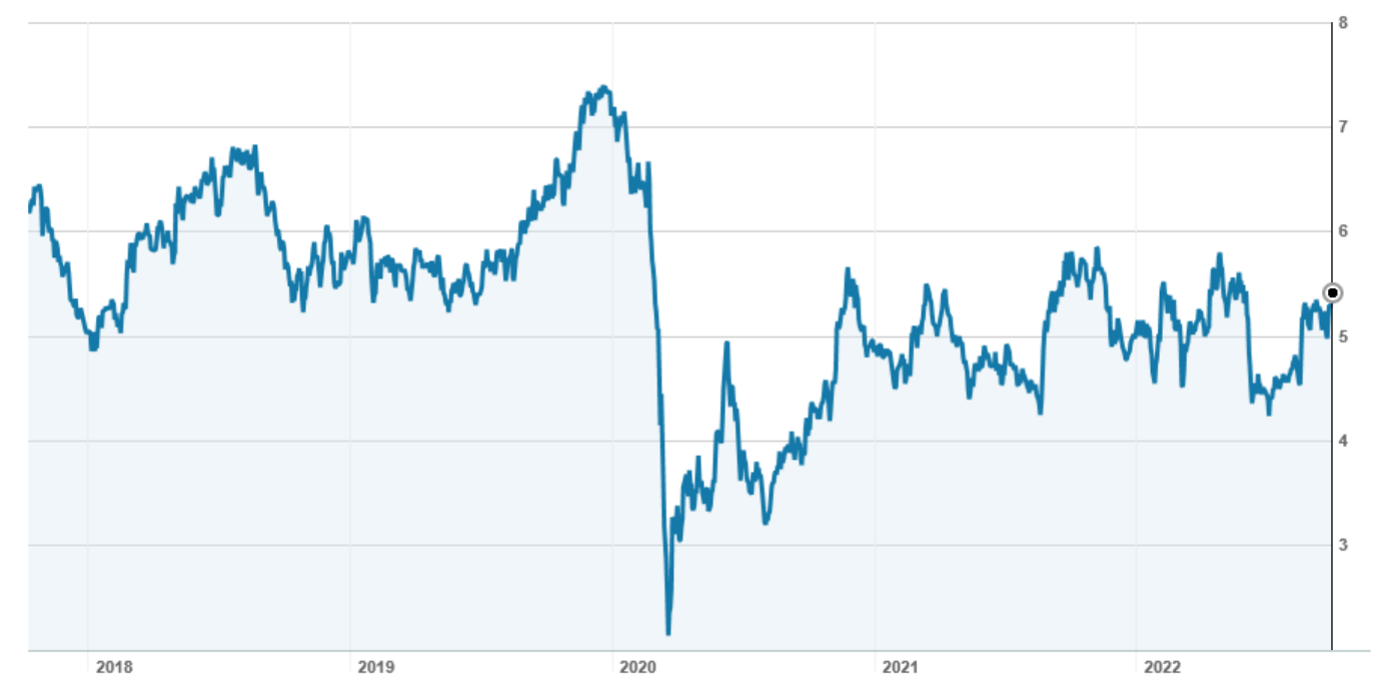A former expert contributor to the Switzer Report, Charlie Aitken, used to say that some of his best and most successful investment ideas came from things he could directly observe.
I have just come back from a trip to London. I flew both ways with Qantas and the flight was packed. Moreover, I have tried to book another flight for later this year and prices are through the roof. I have had friends recount similar experiences, and while staying in London, some business colleagues couldn’t find a fare back to Australia on any airline. I am told that domestic travel is not much better, with prices hitting record highs.
No one is surprised that air travel has rebounded so strongly after Covid. This was always going to happen as lockdowns ended and people got their freedoms again, particularly as discretionary incomes are strong. That’s why the Qantas share price has remained firmly bid and held up well throughout the pandemic, despite record losses.
Qantas (QAN) – October 17 to October 22

The questions for investors are whether the recovery is fully priced in, given the extraordinary level of current demand. Further, with Qantas using the crisis to re-position its cost base and strengthen its position in the duopoly domestic market, are these financial drivers fully understood? Let’s see what Qantas and the major brokers have to say.
Qantas in FY22
At a headline level, Qanats lost $1,859m in FY22. But as capacity returned, the second half loss of $580m was a significant improvement on the first half loss of $1,280m. EBITDA for the second half was positive at $526m.
Capacity, defined in relation to the pre-Covid situation in FY19, averaged 18% in the first half and 50% in the second half. It reached 63% in the final (June) quarter.
This was also the time that Qantas incurred substantial flight cancellations, passengers’ bags were lost, and telephone calls went unanswered as the call centre wait times blew out. Qantas customers were offered a $50 flight credit as “compensation”, costing the airline $160m.
Qantas claims that service levels are getting back to normal, with data for August showing improved on time departures, fewer cancellations, a big improvement in lost luggage, and call centre wait times back to pre- Covid levels.
On a segment basis, Qantas Domestic delivered positive EBIT in the final quarter as seat capacity reached 98% of pre Covid levels. Jetstar didn’t do quite as well domestically, and was further impacted by the delay in restarting international operations.
Qantas freight was a standout, providing a natural hedge to the international passenger business. The latter improved as routes re-opened and capacity was added. With Japan set to re-open shortly, all routes except China are now operational.
Loyalty, the Qantas Frequent Flyer Programme, delivered a strong result. Underlying EBIT rose by 7% to $282m (second half double digit percentage), as members topped 14m, partners were added and points redemption in the final quarter returned to pre Covid levels.
Financially, net debt fell from $5.9bn to $3.9bn, below Qantas’s target range of $4.2bn to $5.2bn. It is awash with liquidity as forward passenger bookings reach record levels. Qantas has an investment grade credit rating and Moodys has returned its outlook to “stable”.
Confidence in the strength of the balance sheet and earnings outlook allowed Qantas to announce a surprise $400m ‘on-market’ share buyback when releasing its annual results.
Fuel costs are expected to rise from $1.85bn in FY22 to around $5.0bn in FY23 due to increased capacity, higher oil prices and increased refining margin. Qantas says that this is about 75% hedged. The higher costs will effectively be passed onto customers and managed by route capacity management.
Cost benefits of $270m were realised in FY22 bringing the total achieved under the Group’s Covid recovery plan to $920m since FY20. It says that it is on track to achieve an annualised benefit of $1bn by FY23.
What do the brokers say?
The brokers are positive on Qantas. According to FN Arena, of the six major brokers who cover the stock, there are five ‘buy’ recommendations and one ‘sell’ recommendations The consensus target price is $6.37, 19.1% higher than Friday’s closing ASX price of $5.35. Target prices range from a low of $4.72 from Citi through to a high of $7.40 (from Ord Minnett).

Looking at earnings, the brokers forecast Qantas to be profitable in FY23 with earnings per share of 45.1c, rising to 75.5c for FY24. This puts Qantas on a forecast multiple of 11.9x for FY23 and 7.1x for FY24.
Bottom line
Notwithstanding the risk in owning an airline, Qantas looks like a ‘buy’ to me. While personal experience is playing a major part in my thinking, it is also supported by the metrics and the views of the major brokers.
A rising oil price and higher short term operating costs to address service issues could work against Qantas, but I am guessing that an insatiable demand to travel will offset these negatives.
Important: This content has been prepared without taking account of the objectives, financial situation or needs of any particular individual. It does not constitute formal advice. Consider the appropriateness of the information in regards to your circumstances.